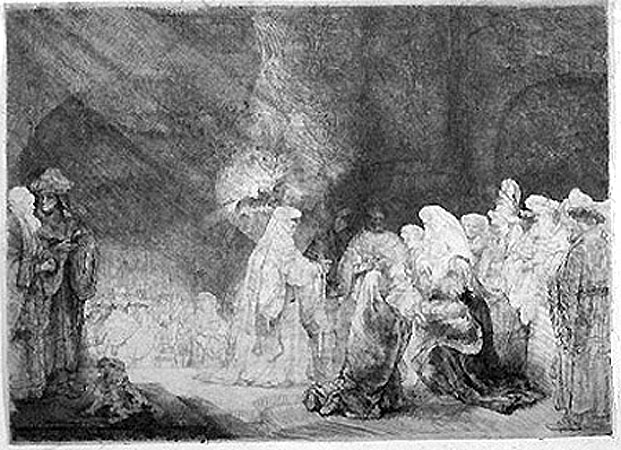Rembrandt Presentation in the Temple Etching with drypoint
Rembrandt Presentation in the Temple
Rembrandt van Rijn
(Dutch 1607-1669)
Presentation in the Temple
etching and drypoint, 1640
8 1 / 2 x 11 1/2
[ text:
Rembrandt van Rijn is indisputably one of the great masters of printmaking. To discuss his full capacities as an artist in a single entry would do him little justice. However, in discussing The Presentation in the Temple, a brief sketch of his printmaking techniques and subject matter is required. During his lifetime, Rembrandt made more than two hundred prints. The Presentation is done in the style of The Hundred Guilder Print, produced in 1639. 1 That time period marks a transition from Rembrandt ‘s earlier style and experimental years to the style of his later years when he had full command of his etching and drypoint technique. Up until 1640, Rembrandt had achieved tonal gradations mainly through multiple acid bitings (sometimes using vinegar). He used drypoint only for final touches. By the time of The Presentation in the Temple, Rembrandt had investigated to its limits the process of pure etching and increasingly used the drypoint technique. 2 His ability to successfully blend these techniques frequently makes it impossible to determine the difference between the two. The Presentation in The Temple can be considered one of his first prints that used the drypoint technique to fully carry the intention of the print. With it, he could easily create the shadowy, dark areas seen in this print and others done in the same manner.
The Presentation is an example of the many prints that Rembrandt executed from stories in the Bible. At least one – third of his work is devoted to biblical subjects, quite surprising considering the influence of Calvinist theology in the Netherlands. 4 Typical of Reformation iconoclasm, Calvin ‘s teachings devalued the representations of biblical figures. Rembrandt, however, was religiously independent all his life. He may have inherited a deep spirituality from his mother, whom Rembrandt often represented holding a Bible. 5
The Presentation in the Temple is a subject that obviously interested Rembrandt greatly. He did at least two other engravings and several paintings based on the subject. His first painting of the theme was done when he was twenty – three, and an unfinished painting of the same subject remained on his easel at the time of his death. 6 The print in the collection is called the oblong print] to distinguish it from the other versions which are referred to as the Small Presentation of 1630 and the Maniere Noire Presentation of 1657. The story of Christ child presented to the elder Simeon is told in Luke 2.22-39. Simeon, who was a very religious and devout man of God, was promised that he would not see his death before he had seen the Savior. Simeon is here seen in the temple holding and blessing the tiny Jesus as his parents, Mary and Joseph, look on. Mary is kneeling beside Simeon, while Joseph stands behind the group of kneeling figures, holding a pair of turtle doves. Central also to the unfolding drama is Anna, the old prophetess who was also promised to see the Christ before her death. Holding a cane and walking toward the group, the Holy Spirit is seen above her shoulders. A dog in the foreground adds a touch of the mundane, transforming the spiritual event to a more human one. In this print, Rembrandt uses light to highlight the focus of the story. The light, seeming to come from an internal, mystical source, is characteristic of Rembrandt’s many etchings. His use of shadow creates a feeling of vaulted space. The people throughout the print exhibit the gamut of human emotions and are perhaps studies of people Rembrandt knew. Hind has noted that no impression of this print was entirely successful, due to either the softness of the metal, problems that Rembrandt had in composing the print, or light-biting practices.7 There may be as many as six states for this print, but most catalogues list only three. The print in this collection is the second state.8 This state is marked by a black skull cap on the image of Simeon that is lacking in the first.

